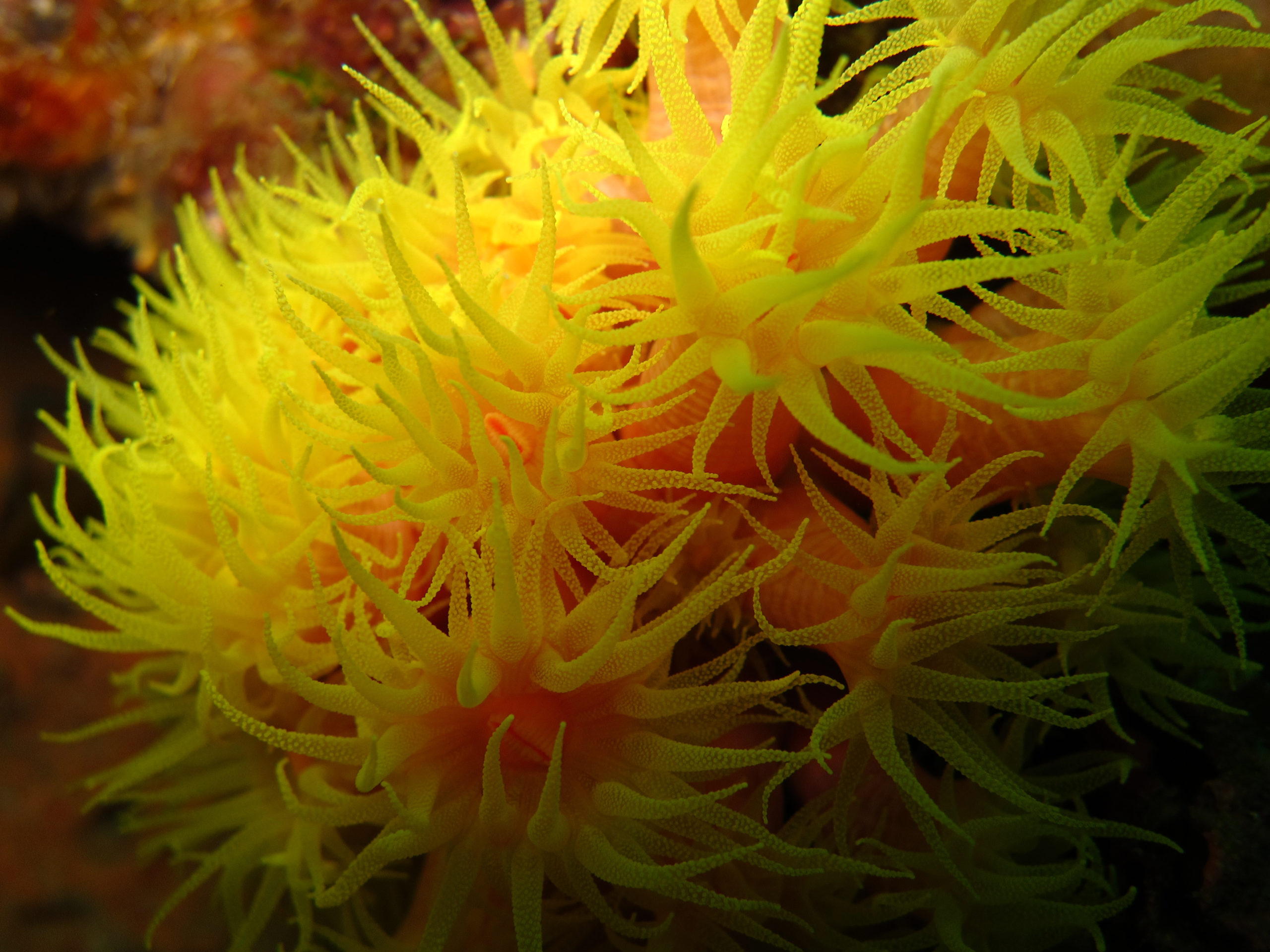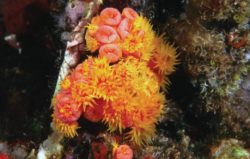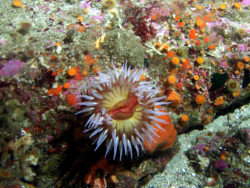
Sea Wonder: Orange Cup Coral

Invasive Orange Cup Coral in Flower Garden Banks National Marine Sanctuary. Photo: NOAA
Corals are known for their sedentary lifestyles, but the orange cup coral made its way from its natural habitats in the Indo-Pacific region of the ocean all the way to the Western Atlantic in the 1940s, making it an invasive species. It is vibrant and unique, and, with no natural predators or role in the ecosystems it ventured to, changed their new food webs.
Description
The orange cup coral (Tubastraea sp.) is a hard coral species that resembles an anemone. Its small, individual polyps (that resemble rigatoni pasta) are cylindrical with tapered, brightly colored tentacles extending from the top. They are not considered a reef-building species of coral, though their polyps are attached to a cup-like limestone skeleton attached to the ocean floor or another sturdy surface like dock pilings, underwater caves, or offshore oil rigs.
Diet & Habitat
Originating in the warm waters of the Indo-Pacific Ocean, orange cup corals lack symbiotic algae that are characteristics of other coral species, which means it does not receive its nutrients from photosynthesis. Instead, they are sessile suspension feeders, a fancy way of saying their flowing “arms” sting and grab small animals and organic particles that pass by.
Since they don’t get their food from algae, they don’t have to live in shallow areas of the ocean that are warm and well lit. They do best in areas where water flows constantly to increase their chances of feeding. They can survive on shaded vertical structures like dock pilings, in kelp forests, in deep tide pools, and along rocky areas and caves. They can live in cold and warmer waters, making them hardier than many other coral species that have temperature sensitivities. Its native range is near southeast Asia, Australia, and the Pacific Islands, and from British Columbia and Alaska down to Mexico. However, they now also span from Caribbean waters near Puerto Rico, the Gulf of Mexico, and along the coast of Brazil. Their invasive range includes Florida Keys and Flower Garden Banks national marine sanctuaries.
Life History
Like other species of corals, orange cup corals begin their lives as planktonic larvae, which are carried by the ocean currents for as many as 14 days until they find a place to settle for life. Once settled, individual polyps form a cup-shaped, limestone skeleton to cement themselves to whatever structure they find suitable, and that skeleton continues to grow along with the polyp throughout its lifecycle. They don’t build reefs or large colonies, but groups of polyps are often found close together.
First observed in Puerto Rico in 1943 and on ship hulls in 1948, scientists believe these corals first made their way to the Western Atlantic by hitching a ride and spawning along the way. Ship ballast water – the water held in large ships to maintain stability and maneuverability – is a common way for invasive marine species to make their way into new ecosystems, and could be another way we unknowingly transported orange cup coral larvae from one side of the ocean to the other.
Threats & Conservation
Orange cup corals are vulnerable to ocean acidification, which weakens their limestone skeletons, but these animals actually pose a threat to other species in their non-native habitat. They displace sponges and soft corals, spreading and growing rapidly and leaving little room for native species to settle and grow. This poses risks to ecosystems and food webs since species of plants, invertebrates, and vertebrates are not adapted to live with orange cup corals. Some research even indicates that the orange cup coral uses chemical defenses to prevent predation and settlement by other organisms.
In Flower Garden Banks National Marine Sanctuary, sanctuary staff work to physically remove orange cup coral from the reef to keep it from establishing itself in the ecosystem and becoming a widespread problem. In other areas, it may be impossible to eliminate this challenge, but solutions like physical removal may reduce the pace or range of this ocean invader’s spread.

Fish eating anemone surrounded by orange cup coral in Cordell Bank National Marine Sanctuary. Photo: Michael Carver/NOAA
